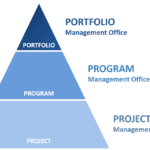The Complete Guide to the Project Management Office
In this complete guide to the Project Management Office (PMO) we will break down in detail the difference between a PMO and an EPMO. In order to do this, we will go in-depth to review what a PMO is, what it does, what the benefits are, and PMO frameworks. From there we will cover what an Enterprise PMO is and does and provide an organizational structure between PMO’s and EPMO’s and EPMO framework.
What is a PMO?
Organizations that rely on project and program management to deliver critical products and services often set up what is referred to as a PMO. The acronym PMO is typically used for a “Project Management Office”, but as we will see, the “P” in PMO is very important to understanding the structure, role, and responsibilities of that team. The “P” can refer to Project Management Office, Program Management Office, or even Portfolio Management Office. A PMO is a full-time group dedicated to project, program, and/or portfolio management. We will focus on the Project Management Office in this guide since it is the most common type of PMO.
The Project Management Institute has a definition of PMO in its PMBOK Guide Seventh Edition:
”A project management office is an organizational structure that standardizes the project-related governance processes and facilitates the sharing of resources, methodologies, tools, and techniques. The responsibilities of a PMO can range from providing project management support functions to direct management of one or more projects.”
The Primary Scope of the PMO versus the Scale of the PMO
In this section we will summarize both the primary scope of a PMO as well as the scale of the PMO. Fundamentally, the scope of the PMO is centered around projects, programs, and portfolios.
- PROJECT Management Office: focused on managing projects
- PROGRAM Management Office: focused on managing programs
- PORTFOLIO Management Office: focused on managing the portfolio
The scale of the PMO refers to the size of the PMO in relation to the organization. A Departmental PMO is centered around a single department (or division/business unit) within the company. An Enterprise PMO (discussed at length below) is a PMO that supports the entire enterprise. Later we will cover the PMO framework and EPMO framework.

What is a PROJECT Management Office (PMO)?
As the name implies, a Project Management Office is focused on projects and project management. The structure of the Project Management Office is dependent upon whether the PMO will have dedicated Project Managers for project delivery or if the PMO is established to provide guidance and support around project management best practices, tools, templates, and project management training.
The most common PMO model is the Project Management Office that has a team of Project Managers who are directly responsible for managing projects. In this model, there is management oversight by a PMO Director (or a VP or even PMO Manager) who sets the direction for the PMO and supports the Project Managers. This team will report up to a senior leader within the organization.
A less common PMO model is where the Project Management Office is set up to establish project management standards, provide tools and templates, consult with project teams, provide project management training, and may report out on project status and progress. This model may be used when there a decentralized approach to project management and Project Managers may report to various leaders within a department. In this model the PMO does not have direct responsibilities in managing projects.
What Does a Project Management Office Do?
In this section we will cover the primary responsibilities of a Project Management Office. We will start with the primary responsibilities from a project management point of view (as shown by the image below). We will then briefly discuss portfolio management.
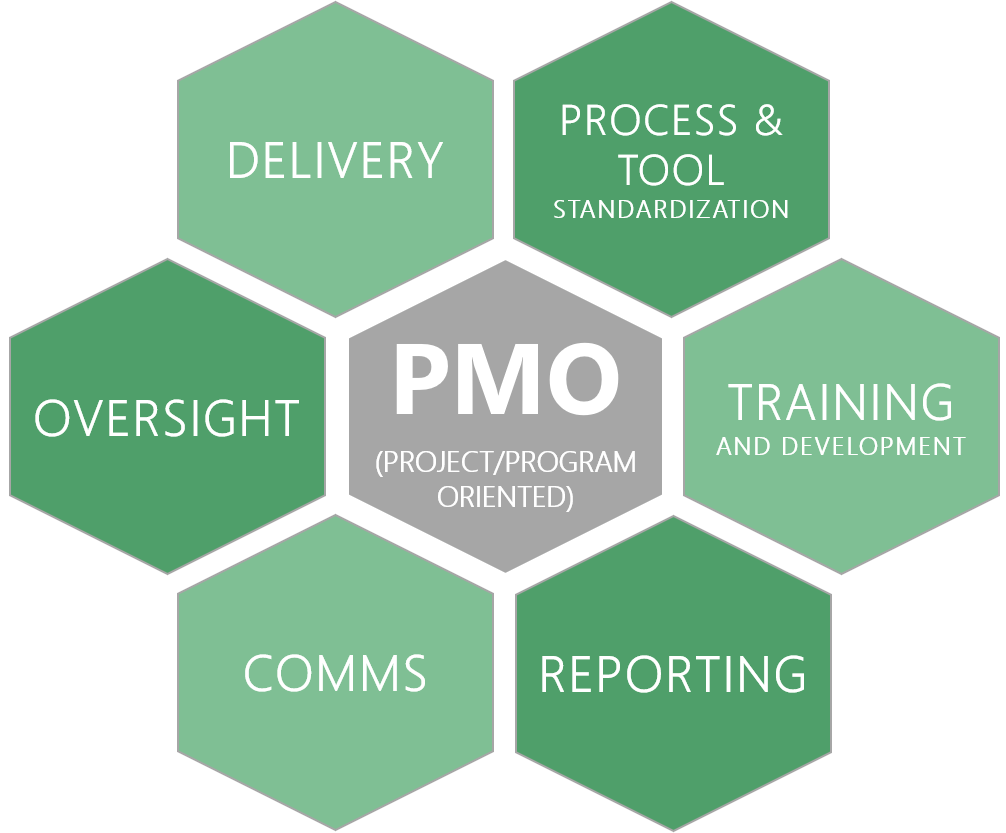
- Project Delivery and Coordination: the most important function of a Project Management Office (from a project management standpoint) is the successful execution and delivery of critical projects.
- Project Oversight: the PMO must maintain oversight of all projects being managed. This oversight starts with the PMO Director but extends to status reporting and monitoring project performance.
- Process Standardization: a good PMO will develop common processes to be followed in order to standardize project management which should result in consistent delivery, which can include project planning, risk and issue management, scheduling, project close-out, etc. The PMO will help define the project management methodology and framework (waterfall, Agile, SAFe, etc.).
- Tools and Template Standardization: in addition to process standardization, a PMO should standardize the software tools and project templates used by the Project teams. Understanding the different types of projects being managed and the appropriate tools needed to deliver those projects will support a more successful project delivery and increase Project Manager morale.
- Training and development: a good PMO will provide ongoing training and development support. A common PMO model will include junior level and senior level Project Managers. The PMO Director should ensure that the junior Project Managers develop into Senior Project Managers over time.
- Reporting: The PMO should have adequate support to provide the necessary portfolio management charts and reports needed to communicate progress out to the governance team and other senior leaders. Status reports are the most common form of project reporting that a PMO is responsible for. When a PMO includes portfolio management disciplines, there are a number of additional reports to be created and shared.
- Communication: the PMO should regularly communicate with the organization (check out our video on portfolio communication). This communication includes the processes utilized by the PMO to manage projects, current project performance, risks and issues, and project close-outs.
VIDEO: What is a PMO?
What Are the Benefits?
In this section we will cover the benefits of setting up a Project Management Office.
- More successful delivery: the number one reason for setting up a Project Management Office is to increase the success rate of project management. Successful project delivery will lead to greater value delivery and higher customer satisfaction. The concept is that if there is a dedicated group of people trained in project management with a common set of processes and tools, project delivery will be more successful.
- Consistent delivery approach: the second reason for a PMO is to have consistent project delivery. A corollary to the first benefit is that if there is a consistent approach to managing projects, this will lead to more successful projects. Having process standards leads to consistent project delivery. Such standards can reduce onboarding of new team members, reduces the time spent managing projects, and reduces the friction from cross-functional team members by not having to learn or follow multiple ways of managing projects.
- Increased coordination across projects: a PMO with a team of Project Managers facilitates better communication across projects. The PMO Director has oversight of the PMO and can foster communication across teams when positive or negative trends are spotted. Learning opportunities can be shared across the entire Project Management team and project interdependencies can be identified earlier and easier in the project lifecycle.
- Portfolio management: we will cover project portfolio management in more detail in the section on Portfolio Management Offices, but a Project Management Office contributes significantly more value when it also takes on portfolio management responsibilities. The goal of projects is to deliver value back to the organization through products and services, and the goal of project portfolio management is to maximize value delivery.
- Better utilization of Project Managers: with a PMO, the PMO Director has more flexibility to assign the right Project Manager to the right project and better utilize the team. When Project Managers work in a decentralized environment, they may not be optimally utilized, nor will the Project Managers as a whole be optimally utilized.
- Better support for Project Managers: one role of the PMO Director is to coach and support the team of Project Managers. Without a PMO, an individual Project Manager may not get the training, support, and coaching needed to grow as a Project Manager. At the team level, a PMO fosters better collaboration among peers.
- Enhanced organizational communication: one of the roles of the PMO is to communicate out to the organization about project performance, project completions, and general instruction on how the project management process works. This healthy communication helps keep the rest of the organization informed and aligned on how projects operate. Without a PMO, such communication is very unlikely to take place.
What are the Primary PMO Roles?
In this section we will focus on three project management related roles: Project Manager, Project Coordinator, and the Project Administrator.

- Project Manager: A Project Manager is a project leader with a particular set of skills to lead a team to deliver a new product, service, or other outcome. A good Project Management Office will possess a variety of Project Managers with different skill sets and levels of experience in order to assign the right Project Manager to the right projects. Good Project Managers possess a balance of soft skills and technical skills to be able to plan, communicate, and manage work.
- Project Coordinator: A Project Coordinator may be likened to a junior project manager and may be assigned more of the technical and logistical aspects of project management such as coordinating meetings, note taking, data entry, schedule updates, status tracking, etc. A Project Coordinator might lead smaller and easier projects or they may be paired with a more senior Project Manager to support on larger and more complex projects.
- Project Administrator: Some organizations utilize a Project Administrator role which is very often involved with the logistics of supporting a Project Management Office (PMO). The Project Administrator may support a PMO Director to facilitate status review meetings, governance meetings, collect status for project teams, etc.
What is the difference between a PMO and a Project Office?
We have covered a Project Management Office in detail, but there are cases where a dedicated Project Office is needed as well. A Project Office is a structure used to execute a single project that is very large and expensive (e.g. ERP implementations). Due to its size, a Project Office has its own hierarchy and will usually have several full-time dedicated team members. A Project Office may (or may not) report directly to the PMO Director.
Common Challenges Facing PMOs
Project Management Offices have their own unique challenges. Based on interviews with PMO Directors at companies such as T-Mobile, Travelers Insurance, University of Washington Medical Center, Blue Cross/Blue Shield of California, Expedia, and Alaska Airlines we have compiled some of the challenges faced by Project Management Offices.
- Value delivery: Executive Leadership cares about whether or not a project delivered the intended value. Project success metrics such as being on schedule, on budget, and on quality are secondary compared to delivering value. PMO Leaders and Project Management need to understand this important concept and learn how to communicate value across the organization. For this reason, portfolio management should be an integral component of any PMO. Once a Project Management Office assumes responsibility for project portfolio management (PPM), it has a clear path to communicating and demonstrating value.
- PMO justification: when a PMO is merely focused on “doing” projects rather than communicating value delivery, it becomes increasingly difficult to justify the existence of the PMO. Without an emphasis on value delivery, the PMO is in fact left to the traditional metrics of being on time and on budget. However, once the PMO starts failing to delivery on time and on budget, leadership will question the importance of the PMO at all, which may lead to disbanding the PMO. The lifecycle of an average Project Management Office is about four years. You can learn more about the PMO lifecycle from the book “The PMO Lifecycle: Building, Running, and Shutting Down” by Bill Dow (PMO expert). While there can be positive reasons for shutting down a PMO, many times it is due to not living up to the expectations set when the PMO was first established. When a PMO consistently communicates, demonstrates, and delivers value, it will become a pillar in the company. Otherwise, it will eventually get disbanded.
- Order taker versus strategic partner: without project portfolio management, a Project Management Office becomes little more than an order taker on what projects to do next. Project portfolio management breaks this cycle and positions the PMO to be a critical partner in strategic execution.
- Project police: if a PMO focuses more on adherence to process and documentation than it does to value delivery, it will receive a negative reputation as a police officer merely policing project teams to fill out forms correctly and on time. Process standardization adds value, and accountability is needed, but over-policing project teams will lower morale and deflate Project Managers.
- Communication: Some Project Managers still struggle to communicate effectively with senior leadership; they need coaching to focus on outcomes, not merely on what was done. Project Managers have a bad habit of communicating WHAT they are doing instead of the VALUE their project will deliver. From an Executive Sponsor, “I’m not interested in what you did, I want to know what value/outcomes were achieved”. “As project management practitioners we tend to lead with project mechanics (scheduled, budget, resources). Exec sponsors want to hear about value and benefit realization”. Generational issues may also be at play, “younger Project Managers can’t handle the communication with executives, they prefer to text and IM”. These are sober warnings to PMO Directors to coach and train their Project Managers on how to communicate.
“There was a night and day difference between Company 1 and Company 2 in terms of the pressure I felt. At Company 1, I was constantly worried about my Project Managers and constantly had to justify their existence (so they do not get laid off). It is a lot of weight to carry.” – PMO Director at a Telecommunications company
What is a PROGRAM Management Office?
As the name implies, a Program Management Office is focused on programs and program management. The structure of the Program Management Office depends on whether the PMO will have dedicated Program Managers for program delivery or if the PMO is established to provide guidance and support around program management best practices, tools, templates, and training.
The Program Management Office is the rarest form of a PMO for several reasons. Program Management as a separate discipline from project management is still growing, and most organizations involved with project management will set up a Project Management Office. However, there are cases where a Program Management Office is utilized to help setup and manage distinct programs. Some companies may initiate a single program to help fulfill a specific strategic objective. At one fashion retail company, the supply chain organization set up a Program Management Office to take a more strategic approach to accomplishing organization goals, but decentralized other types of projects.
Although less common, the more common approach to a Program Management Office would be to have Program Managers staffed who can provide program oversight and delivery. The other PMO model is where the Program Management Office is set up to establish program management standards, provide tools and templates, consult with project teams, and provide program management training. This model may be used when there a decentralized approach to program management and Program Managers may report to various leaders within a department. The Boeing Company utilized this type of decentralized Program Management Office to train a multitude of people on program management best practices.
What is a PORTFOLIO Management Office?
At the name implies, a Portfolio Management Office focuses on project portfolio management. This model does not directly involve project delivery but fulfills the scope of portfolio management. If the PMO includes both project delivery and portfolio management, it would commonly be referred to a Project Management Office. However, in some organizations, the portfolio management function is separated from the Project Management Office. A separate and dedicated team of Portfolio Managers and Portfolio Analysts support the portfolio management process. The image below captures some of the essential capabilities of a Portfolio Management Office.
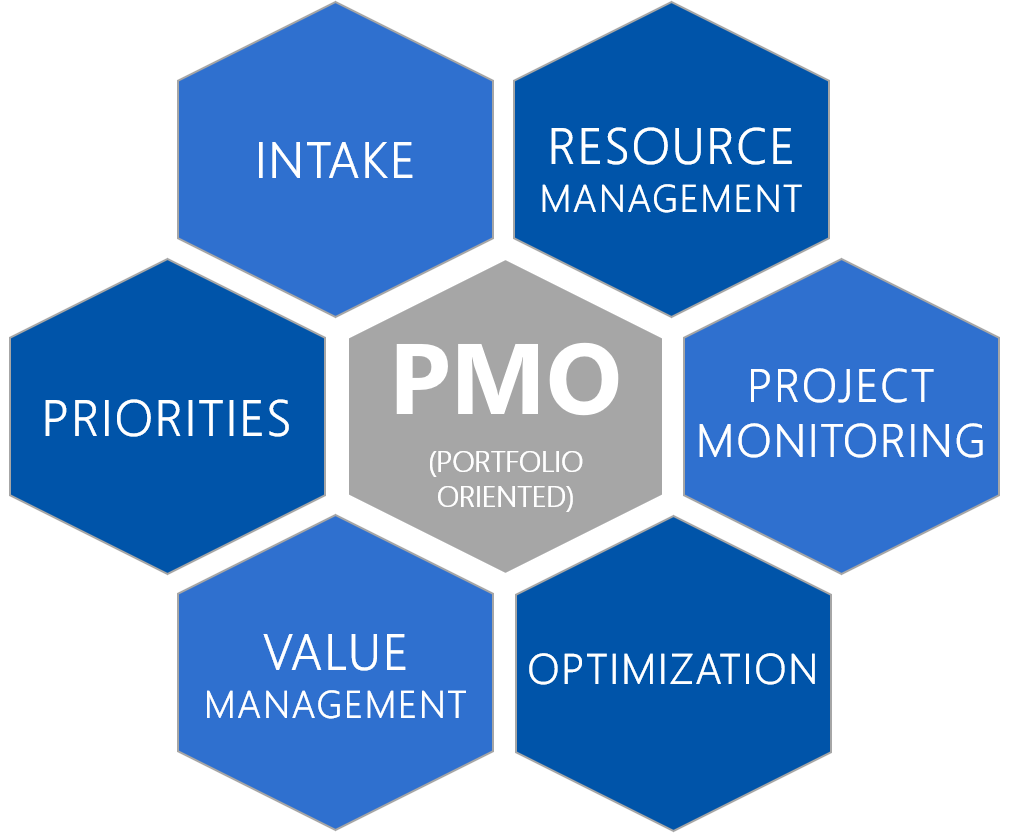
A detailed explanation of each of these capabilities is covered in the respective link:
- Work Intake – refers to the steps of developing a project proposal and bringing it to the governance board for a go/no-go decision. The Portfolio Management Office will oversee the work intake process to ensure that the best projects and programs are selected.
- Prioritization – The Portfolio Management Office will oversee the project prioritization process to help evaluate project value in order to assign resources to the most important projects and start work at the appropriate time.
- Portfolio Value Management – the Portfolio Management Office helps evaluate, measure, and track project benefits at the portfolio level.
- Portfolio Optimization – refers to optimization techniques used to identify the optimal grouping of projects that maximize the risk-adjusted portfolio value at a given budgetary level.
- Project Tracking – While a Project Management Office focused on individual project performance, a Portfolio Management Office will maintain surveillance of all projects in order to report back to the governance team on aggregate portfolio health and performance.
- Resource Capacity Planning – a Portfolio Management Office will be the key player in making resource capacity planning successful by future resource utilization of project resources against available capacity to do work.
Common PMO Frameworks
In this section we will cover PMO frameworks. The structure of the PMO will depend on the scope and objectives of the PMO. There are three primary types of PMO’s that intersect with the three categories (scope) of the PMO.
- DELIVERY PMO: The Delivery PMO is about the actual management of projects, programs, and portfolios. This type of PMO has dedicated employees trained on how to manage projects, programs, and portfolios. As the name implies, the focus is on execution and delivery. Generally speaking, this is the most common type of PMO as it includes the necessary people to actually get the work done. A PMO Director (or equivalent) would be responsible for establishing project management standards for the PMO and would oversee the development of processes, tools, and templates.
- CENTER OF EXCELLENCE (COE) PMO: The Center of Excellence PMO emphasizes standard processes, use of common tools and templates, and likely provides training on how to manage projects and programs. This type of departmental PMO would likely be found in very large departments in large companies. The COE PMO may be used when leadership wants to establish common standards around project and program management without having a centralized team of Project and Program Managers.
- DEDICATED: a dedicated PMO is established for a specific purpose for a limited period of time. This is referred to as a ‘Project Office’. In this case, a project or program is so large that an organizational team has been established with dedicated team members with line managers involved.
In the PMO framework image below, the table depicts the three types of PMO intersecting with the Portfolio Management Office, Program Management Office, and Project Management Office. Based on industry experience, a general notation of how common the PMO is in practice has been provided.
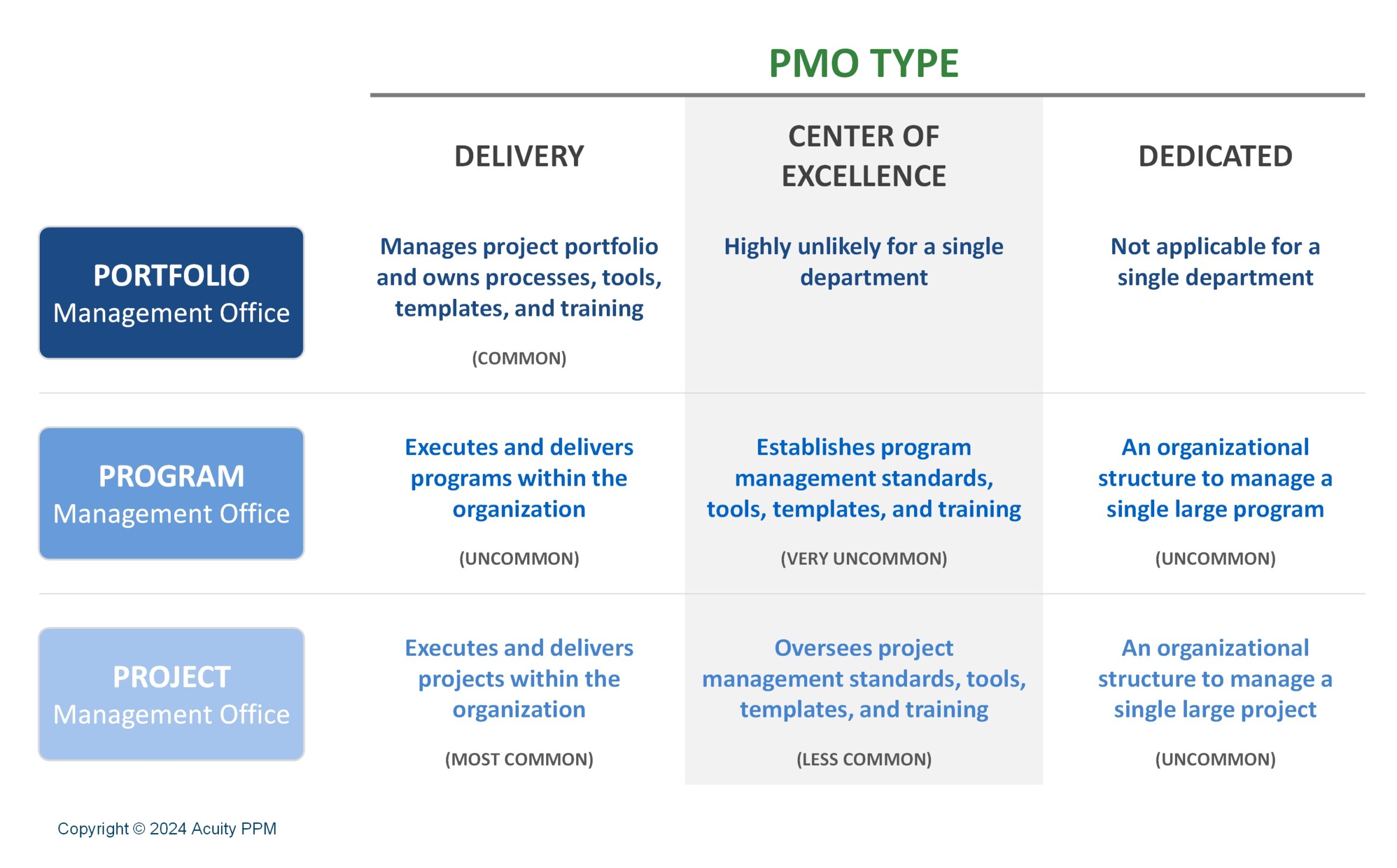
What is an Enterprise PMO (EPMO)?
In this final section we will cover a very distinct form of a PMO, the Enterprise PMO. As the name implies, this is a PMO for the entire enterprise. We will cover the different types of Enterprise Project Office’s (EPMO’s), different structures, and common challenges with the EPMO.
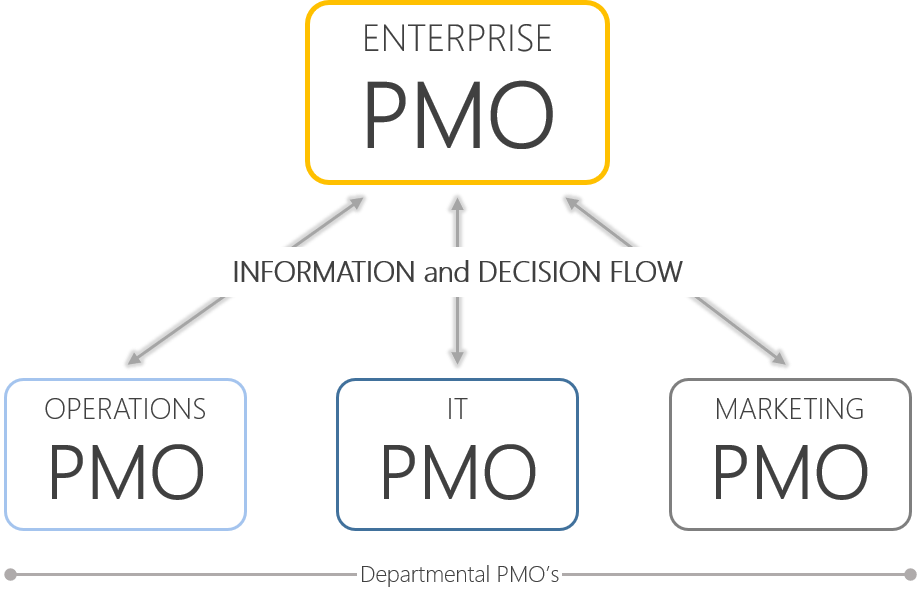
Common EPMO Frameworks
In this section we will cover EPMO frameworks. The structure of the EPMO will depend on the scope and objectives of the PMO. There are three primary categories (scope) of an Enterprise PMO (EPMO):
- The Enterprise PROJECT Management Office: an EPMO that is project-based supports and delivers projects across the enterprise. We will cover this in more detail below related to the different structures of an Enterprise Project Management Office.
- The Enterprise PROGRAM Management Office: as mentioned above, this is the rarest form of EPMO, even rarer than a standard Program Management Office. At an enterprise level, it would be uncommon to focus exclusively on programs and neglect enterprise projects.
- The Enterprise PORTFOLIO Management Office: all of the same capabilities and responsibilities that apply to a Portfolio Management Office also apply to an Enterprise Portfolio Management Office. We will cover this in more detail related to the different structures of an Enterprise Portfolio Management Office
We will emphasize the Enterprise PROJECT Management Offices and Enterprise PORTFOLIO Management Offices as these are the most common EPMO’s.
Enterprise Project Management Office (EPMO) Types
There are three primary types of EPMO’s that intersect with the three categories (scope) of the PMO.
- DELIVERY EPMO (Strategy Delivery Office): The Delivery EPMO is about the actual management of projects, programs, and portfolios. In practice, it would be rare to find an EPMO that exclusively focuses on Programs, so for the remainder of this section we will emphasize Projects and Portfolios. The Delivery EPMO has dedicated employees trained on how to manage projects, programs, and portfolios. The focus of the Delivery EPMO is on strategy execution and delivery. Generally speaking, this is the most common type of EPMO as it includes the necessary people to actually get the work done. Even within a Delivery EPMO, there are some variations.
- In some cases, a Delivery EPMO can be responsible for managing all projects across the enterprise. This form would be most common for mid-sized companies that cannot justify having departmental PMO’s. The EPMO would receive project requests (via the portfolio management process) and would assign Project Managers to plan, execute, and deliver the projects with cross-functional support across the company.
- Another variation is where the EPMO only manages projects that impact the entire enterprise. These would tend to be the largest and most impactful projects. This variation can be referred to as a Strategy Delivery Office (SDO). With a Strategy Delivery Office, the focus is on strategic execution, particularly enterprise projects that drive strategy. The Strategy Delivery Office (SDO) is truly only responsible for enterprise related projects and does not get involved with departmental projects. This assumes that departmental PMO’s are established where needed to support the delivery of departmental projects. The governance structure of this EPMO is different and often reports to the C-Suite or other high-ranking executive.
- An Enterprise Project Management Office may also assume portfolio management responsibilities.
- CENTER OF EXCELLENCE (COE) EPMO: The Center of Excellence EPMO is where the Enterprise Project Management Office is a center of excellence for project management within the company. This arrangement is useful for large companies that choose not to establish an execution-focused EPMO but rather utilize a decentralized approach for managing projects. The EPMO as a Project Management Center of Excellence establishes enterprise-wise project management standards, standard tools and templates, provides project management training, and may consult with project teams to mature project management practices.
- DEDICATED EPMO: a dedicated EPMO is established for a specific purpose for a limited period of time. This is referred to as a ‘Project Office’. In this case, a project or program is so large that an organizational team has been established with dedicated team members with line managers involved.
In the EPMO framework image below, the table depicts the three types of EPMO intersecting with the Portfolio Management Office, Program Management Office, and Project Management Office. Based on industry experience, a general notation of how common the PMO is in practice has been provided.
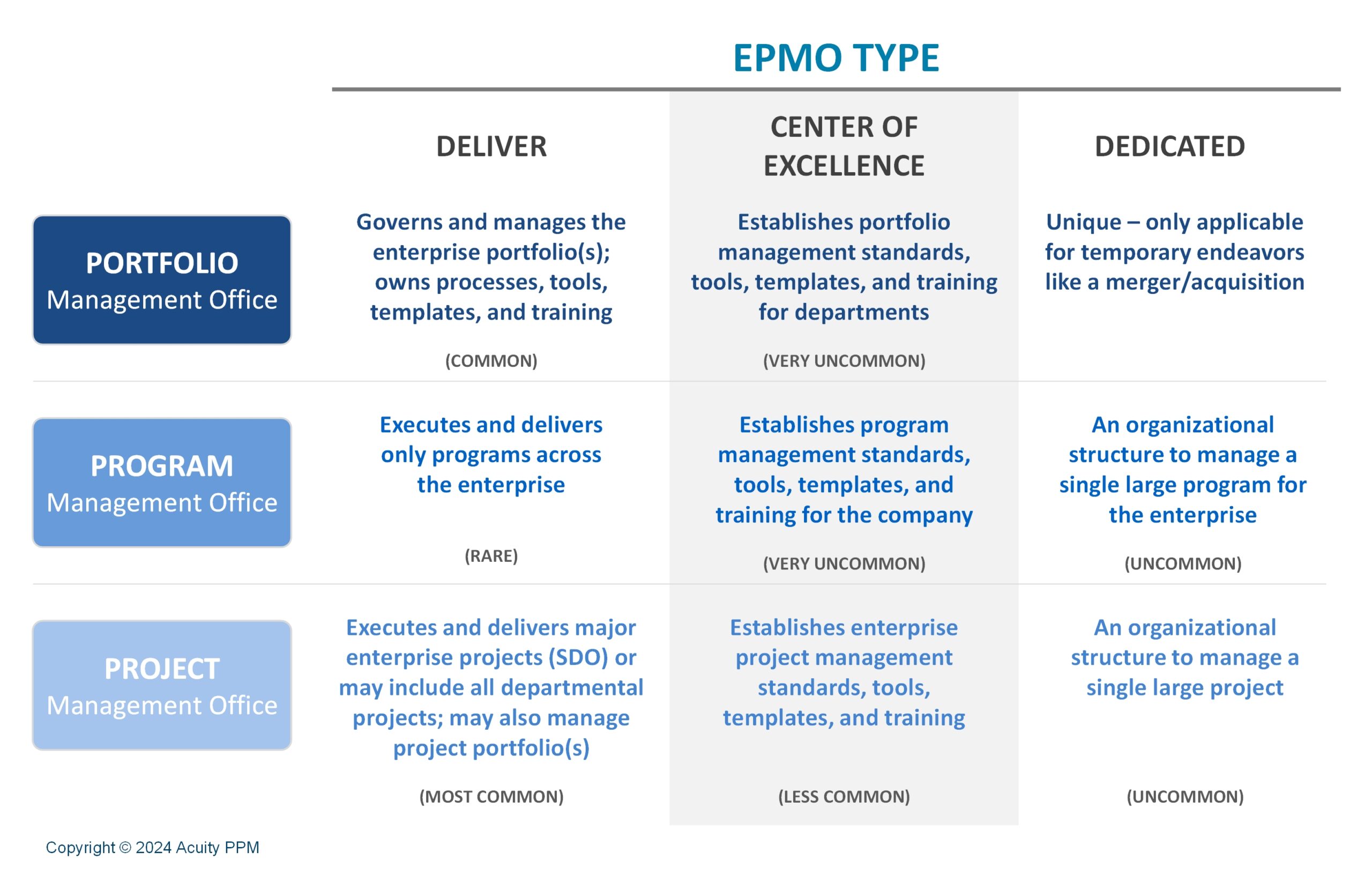
Enterprise Portfolio Management Office
The Enterprise Portfolio Management Office provides portfolio management support across the enterprise. Some organizations choose this model at the enterprise level rather than have a project execution focused EPMO. For less sophisticated or mature organizations, the Enterprise Portfolio Management Office primarily maintains the enterprise list of projects, collects status across all projects to report back to upper management, with some support for prioritization. Unfortunately, this version of the EPMO offers less value than an Enterprise Portfolio Management Office that provides a full spectrum of portfolio management capabilities, especially work intake, prioritization, and resource capacity planning. There can be cases where an Enterprise Project Management Office works together with an Enterprise Portfolio Management Office, but more commonly if both project management and portfolio management are conducted at an enterprise level, this would commonly fall under the responsibility of the Enterprise Project Management Office.
Benefits of an EPMO
There are multiple benefits of utilizing an EPMO and we will summarize five key benefits here:
- Stronger delivery at the enterprise level: utilizing an EPMO can result in better project delivery of critical strategic and enterprise-wide projects. Some EPMO’s assign their best (most senior) Project Managers to critical enterprise-wide projects, resulting in higher quality delivery.
- Enterprise visibility: senior leadership will get better visibility of projects across the enterprise by utilizing an EPMO (assuming that some portfolio management responsibilities are part of the EPMO)
- Focused strategic execution: many of the most critical strategic projects affect the entire enterprise and utilizing an EPMO to manage critical strategic initiatives enables the company to be laser focused on accomplishing strategic goals.
- Standard project management: at the enterprise level, an EPMO can more easily influence and standardize how project management is done within the company.
- Optimal portfolio management: at the enterprise level, an EPMO has the position within the company to have clearer line-of-sight to projects across the company with the opportunity to support more optimal project portfolio management.

Challenges with an EPMO
We conclude this guide to PMO’s and EPMO’s by highlighting common challenges with EPMO’s:
- Governance: organizations that set up an EPMO need to carefully consider the corresponding governance structure for their enterprise portfolio, especially if the EPMO focuses only on strategic projects. In this case, the process for submitting project requests needs to be well defined so that departmental requests get approved through the appropriate channel, but true enterprise requests get escalated to the EPMO. Without having these governance processes defined with departmental leadership aligned, projects can get slowed down or delayed.
- Process: an EPMO has a greater challenge in standardizing and developing good project and portfolio management processes because more business units and people are involved. Standardizing a process to fit disparate organizations (i.e. IT, Marketing, Operations, Finance, Supply Chain, etc.) can be very challenging. Careful consideration is needed and more communication required to ensure longevity and success for the EPMO.
- Data: standardized data follows standardized processes. Yet, different business units, departments, and senior leaders have different data requirements for making portfolio decisions. These data needs must also be considered in conjunction with establishing standard processes, otherwise lower quality decisions will be made, or decisions will be delayed by having to collect additional information.
- Systems: from a portfolio management perspective, it is challenging to support portfolio management at the enterprise level, if each departmental PMO has their own PPM solution. Although integrations between PPM systems are possible, it can be far easier to utilize a centralized portfolio management tool (like Acuity PPM) and integrate with various project management tools as needed. When there are disparate systems, it is difficult to get the right data to flow to the right people at the right time to make better decisions.
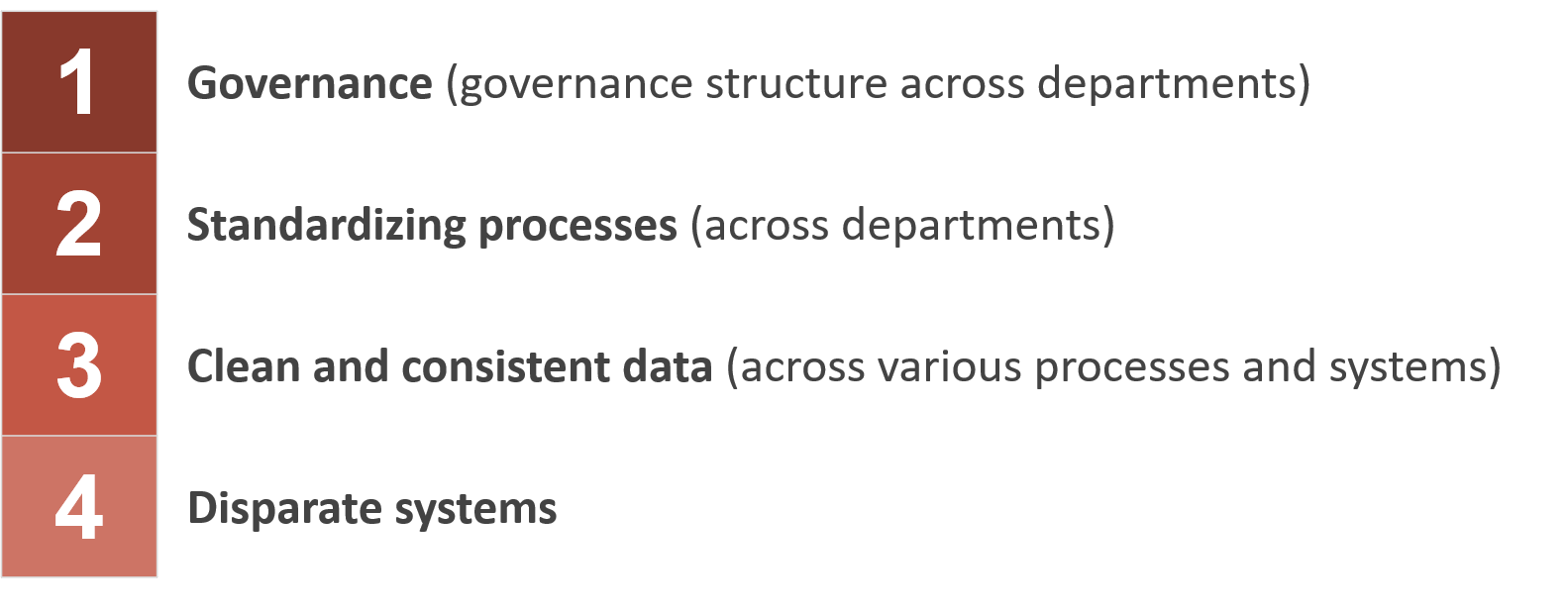
Summary
A PMO or EPMO can add value to an organization when it is set up for the right reasons and done well. Yet there is not a single type of PMO or EPMO; this guide showed what the different types of PMO’s that exist, what they do, and the benefits each provides. Architecting a PMO or EPMO is not easy. In practice, PMO’s continue to evolve. Contact us for more help with setting up your PMO or EPMO.
[activecampaign form=3]
Tim is a project and portfolio management consultant with over 15 years of experience working with the Fortune 500. He is an expert in maturity-based PPM and helps PMO Leaders build and improve their PMO to unlock more value for their company. He is one of the original PfMP’s (Portfolio Management Professionals) and a public speaker at business conferences and PMI events.
What does a Project Management Office (PMO) do?

1) Project Delivery and Coordination: the most important function of a Project Management Office (from a project management standpoint) is the successful execution and delivery of critical projects. 2) Project Oversight: the PMO must maintain oversight of all projects being managed. 3) Process Standardization: a good PMO will develop common processes to be followed in order to standardize project management which should result in consistent delivery. 4) Tools and Template Standardization: a PMO should standardize the software tools and project templates used by the Project teams. 5) Training and development: a good PMO will provide ongoing training and development support 6) Reporting: The PMO should provide the necessary reports needed to communicate progress out to the governance team and other senior leaders 7) Communication: the PMO should regularly communicate with the organization about current project performance, risks and issues, and project close-outs.
What is the difference between a PMO and a Project Office?
A PMO is a departmental team that runs and supports multpiple projects. A Project Office is a structure used to execute a single large project (e.g. ERP implementations). A Project Office has its own hierarchy with several full-time dedicated team members, and will be disbanded when the project is completed.
What does a Portfolio Management Office do?
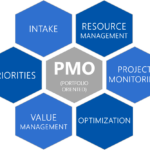
A Portfolio Management Office supports the portfolio management lifecycle through critical capabilities such as work intake, prioritization, portfolio value management, portfolio optimization, project tracking, resource capacity planning, portfolio reporting and analysis, and portfolio communication.
What are the different types of an Enterprise PMO (EPMO)?
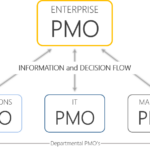
There are three primary versions of an Enterprise Project Management Office (EPMO): 1) Full project management responsibility where the EPMO is responsible for managing all projects across the enterprise. 2) Strategic project management responsibility where the EPMO is truly only responsible for enterprise related projects and does not get involved with departmental projects. 3) Project Management Center of Excellence (COE) where the EPMO is a center of excellence for project management within the company.
Never miss an Acuity PPM article
Don't take our word, listen to what others are saying:
"I find value in all of your articles."
"Your articles are interesting and I am sharing them with my team who have limited project knowledge. They are very useful."



